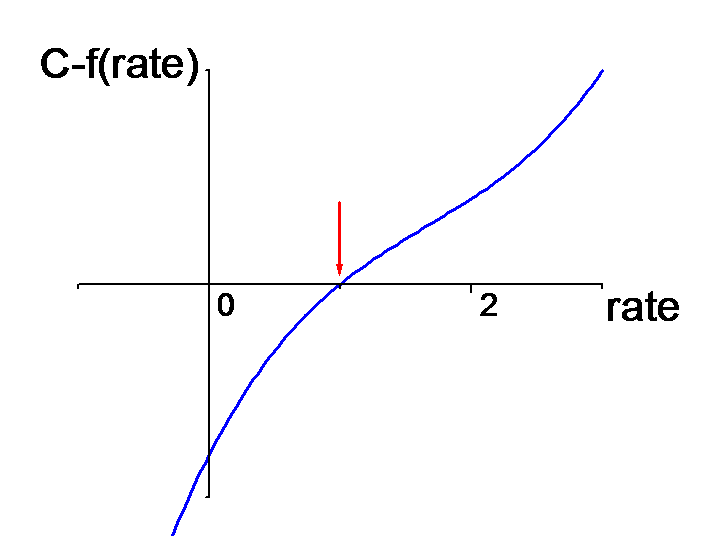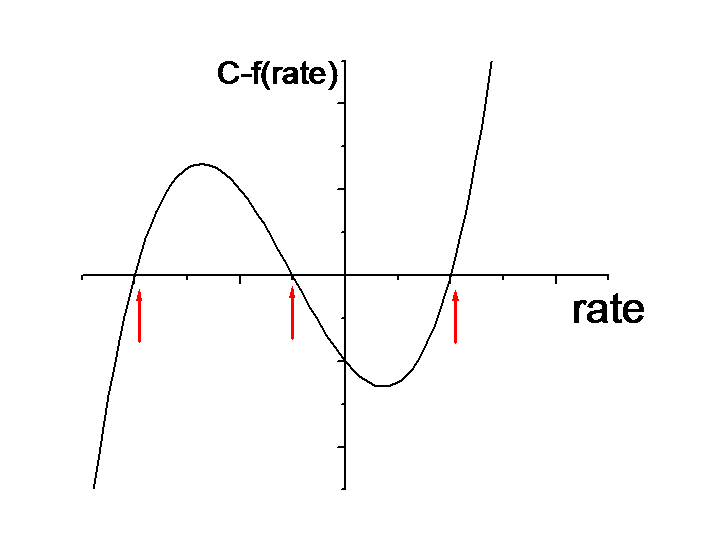Last Updated on October 26, 2020 at 8:57 am
Excel’s IRR and XIRR functions are often used to calculate the rate of investment returns. In this post, let us discuss the limitations of XIRR and IRR functions.
Credit: This discussion is inspired by financial planner Mr. Hari who posted a video describing the limitations of IRR and XIRR on my XIRR calculator page. The video (a must watch for finance professionals) is linked below.
A couple of weeks ago, when the Chit fund returns calculator was published, I had mentioned that, for any investment, if the amount invested is less than the amount received, it might not be possible to calculate the rate of return.
Excels XIRR and IRR functions, or any other code for that matter, cannot handle such situations because there is more than one rate of return possible!
Join 32,000+ readers and get free money management solutions delivered to your inbox! Subscribe to get posts via email! (Link takes you to our email sign-up form)
🔥Want to create a complete financial plan? Learn goal-based investing? Exclusive access to our DIY tools? Increase your income with your skills? Use this link to enjoy massive discounts on our robo-advisory tool & courses! 🔥
In order to understand what this means, let us review some basic definitions.
Cash flow: For the purposes of this post, we define cash flow as receipts – payments.
So if you make a profit in any investment the cash flow is positive and if you incur a loss, the cash flow is negative.
IRR: IRR or internal rate of return is a function in Excel used to calculate the return for any periodic cash flow entries. For example, if you pay insurance premium for 12 months and receive some cash back in the 13th month, you could calculate the monthly IRR and then convert to a CAGR (compounded annual growth rate)
XIRR: If the cash flow entries are not periodic, then XIRR may be used to compute CAGR straightaway using the dates of payments and receipts.
Both IRR and XIRR are approximation methods (we will see why this is necessary below). Therefore, you may have to help them out buy entering a guess for the return.
Let us start a simple situation.
Lump sum investment
Suppose I invest Rs. 100 for 5 years and get Rs. 150 at the end of 5 years, what is the rate of return?
To determine this, we calculate
Compound Interest Formula
Here, rate is the rate of return we need to calculate. First, we rewrite
That is, we can pull the rate to one side of the equation.
When this is possible, we can always determine the rate uniquely. That is, there will only be one answer.
SIP investment
Suppose I run a monthly SIP of Rs. 1000 for 5 years and obtain a corpus of say, Rs. 70,000, what is the rate of return?
In this case, the formula gets a bit complicated!
Here, 12000 is the annual investment. Unfortunately, in this case the rate cannot be pulled to one side of the equation.
- Therefore, we have to estimate the rate of returns and cannot determine it as mentioned in my post on generating MF account statement with returns
- Therefore, we need to estimate the returns from a SIP as mentioned in post on SIP account statement from NAV history
To do this, let us first denote
Here f(rate) simply means a quantity which depends on the rate.
We can now write the SIP formula as
C – f(rate) =0
Here C is the corpus accumulated (Rs. 70, 000 in our example). Now we start guessing the rate.
- If our guess is incorrect, C – f(rate) ≠ 0
- If our guess if correct, C – f(rate) =0
Suppose I draw a graph between C – f(rate) versus all possible reasonable for the rate (say between -100% and +100%) then we might get something like this.
Notice that curve cuts the x-axis at only point. At this point the value of the y-axis is zero (that is C – f(rate) =0).
The corresponding value of the x-axis is the rate of return.
While this is a simple graphical way of calculating the return, there are many mathematical methods to calculate return. Excel’s IRR and XIRR uses a method known as Newton –Raphson method. Here is an excellent review on the subject (strongly recommend resource for all finance professionals)
Calculating rate using such methods work fine, provided the cash flow is positive. That is receipts should be greater than payments.
When the cash flow becomes negative (loss in investment) and in particular a large negative number (huge loss), the plot between C – f(rate) versus rate may look like this.
Notice that the curve intersects the x-axis at three points. This means that there are 3 solutions. That is three different rates correspond to our cash flow entries.
Many find this impossible to believe. Unfortunately, this is not only possible but also quite natural.
If we knew what the three solutions are, we could check them using Excels XNPV function. This function returns a value of zero if the right rate of return is chosen. XPNV will be zero for all possible solutions!
Next week I will post an Excel tool by which we can determine all possible solutions for a given cash flow statement.
Video mentioned above
A look at Excel’s XIRR function
If you read the comments below the video, you may notice that I had an interesting discussion with the author.
Bottomline:
- When the investment loss is huge, multiple rate of returns is possible.
- All such solutions are equally correct
- You cannot pick and choose a solution that you like!
- Typically, for such situations, IRR and XIRR will return an error.
- An error is better because, for some situations IRR and XIRR can produce one of the many possible solutions! This is unfortunate because the user believes the answer without realizing that the result is wrong!
The solution: Do not lose money! That way the cash flow is positive and the return will always be unique. Excels IRR and XIRR are then dependable!
Your view: Do spare a moment to let me know if you were able to follow the discussion. What do you make out of all this? If you can add to this discussion in any way, please let me know.

Use our Robo-advisory Tool to create a complete financial plan! ⇐More than 3,000 investors and advisors use this! Use the discount code: robo25 for a 20% discount. Plan your retirement (early, normal, before, and after), as well as non-recurring financial goals (such as child education) and recurring financial goals (like holidays and appliance purchases). The tool would help anyone aged 18 to 80 plan for their retirement, as well as six other non-recurring financial goals and four recurring financial goals, with a detailed cash flow summary.
🔥You can also avail massive discounts on our courses and the freefincal investor circle! 🔥& join our community of 8000+ users!
Track your mutual funds and stock investments with this Google Sheet!
We also publish monthly equity mutual funds, debt and hybrid mutual funds, index funds, and ETF screeners, as well as momentum and low-volatility stock screeners.
You can follow our articles on Google News

We have over 1,000 videos on YouTube!

Join our WhatsApp Channel



- Do you have a comment about the above article? Reach out to us on Twitter: @freefincal or @pattufreefincal
- Have a question? Subscribe to our newsletter using the form below.
- Hit 'reply' to any email from us! We do not offer personalised investment advice. We can write a detailed article without mentioning your name if you have a generic question.
Join 32,000+ readers and get free money management solutions delivered to your inbox! Subscribe to get posts via email! (Link takes you to our email sign-up form)
About The Author
 Dr M. Pattabiraman (PhD) is the founder, managing editor and primary author of freefincal. He is an associate professor at the Indian Institute of Technology, Madras. He has over 13 years of experience publishing news analysis, research and financial product development. Connect with him via Twitter(X), LinkedIn, or YouTube. Pattabiraman has co-authored three print books: (1) You can be rich too with goal-based investing (CNBC TV18) for DIY investors. (2) Gamechanger for young earners. (3) Chinchu Gets a Superpower! for kids. He has also written seven other free e-books on various money management topics. He is a patron and co-founder of “Fee-only India,” an organisation promoting unbiased, commission-free, AUM-independent investment advice.
Dr M. Pattabiraman (PhD) is the founder, managing editor and primary author of freefincal. He is an associate professor at the Indian Institute of Technology, Madras. He has over 13 years of experience publishing news analysis, research and financial product development. Connect with him via Twitter(X), LinkedIn, or YouTube. Pattabiraman has co-authored three print books: (1) You can be rich too with goal-based investing (CNBC TV18) for DIY investors. (2) Gamechanger for young earners. (3) Chinchu Gets a Superpower! for kids. He has also written seven other free e-books on various money management topics. He is a patron and co-founder of “Fee-only India,” an organisation promoting unbiased, commission-free, AUM-independent investment advice.Our flagship course! Learn to manage your portfolio like a pro to achieve your goals regardless of market conditions! ⇐ More than 3,500 investors and advisors are part of our exclusive community! Get clarity on how to plan for your goals and achieve the necessary corpus no matter the market condition!! Watch the first lecture for free! One-time payment! No recurring fees! Life-long access to videos! Reduce fear, uncertainty and doubt while investing! Learn how to plan for your goals before and after retirement with confidence.
Increase your income by getting people to pay for your skills! ⇐ More than 800 salaried employees, entrepreneurs and financial advisors are part of our exclusive community! Learn how to get people to pay for your skills! Whether you are a professional or small business owner seeking more clients through online visibility, or a salaried individual looking for a side income or passive income, we will show you how to achieve this by showcasing your skills and building a community that trusts and pays you. (watch 1st lecture for free). One-time payment! No recurring fees! Life-long access to videos!
Our book for kids: “Chinchu Gets a Superpower!” is now available!


Must-read book even for adults! This is something that every parent should teach their kids right from their young age. The importance of money management and decision making based on their wants and needs. Very nicely written in simple terms. - Arun.Buy the book: Chinchu gets a superpower for your child!
How to profit from content writing: Our new ebook is for those interested in getting a side income via content writing. It is available at a 50% discount for Rs. 500 only!
Do you want to check if the market is overvalued or undervalued? Use our market valuation tool (it will work with any index!), or get the Tactical Buy/Sell timing tool!
We publish monthly mutual fund screeners and momentum, low-volatility stock screeners.
About freefincal & its content policy. Freefincal is a News Media organisation dedicated to providing original analysis, reports, reviews and insights on mutual funds, stocks, investing, retirement and personal finance developments. We do so without conflict of interest and bias. Follow us on Google News. Freefincal serves more than three million readers a year (5 million page views) with articles based only on factual information and detailed analysis by its authors. All statements made will be verified with credible and knowledgeable sources before publication. Freefincal does not publish paid articles, promotions, PR, satire or opinions without data. All opinions will be inferences backed by verifiable, reproducible evidence/data. Contact Information: To get in touch, please use our contact form. (Sponsored posts or paid collaborations will not be entertained.)
Connect with us on social media
- Twitter @freefincal
- Subscribe to our YouTube Videos
- Posts feed via Feedburner.
Our publications
You Can Be Rich Too with Goal-Based Investing
 Published by CNBC TV18, this book is designed to help you ask the right questions and find the correct answers. Additionally, it comes with nine online calculators, allowing you to create custom solutions tailored to your lifestyle. Get it now.
Published by CNBC TV18, this book is designed to help you ask the right questions and find the correct answers. Additionally, it comes with nine online calculators, allowing you to create custom solutions tailored to your lifestyle. Get it now.Gamechanger: Forget Startups, Join Corporate & Still Live the Rich Life You Want
 This book is designed for young earners to get their basics right from the start! It will also help you travel to exotic places at a low cost! Get it or gift it to a young earner.
This book is designed for young earners to get their basics right from the start! It will also help you travel to exotic places at a low cost! Get it or gift it to a young earner.Your Ultimate Guide to Travel
 This is an in-depth exploration of vacation planning, including finding affordable flights, budget accommodations, and practical travel tips. It also examines the benefits of travelling slowly, both financially and psychologically, with links to relevant web pages and guidance at every step. Get the PDF for Rs 300 (instant download)
This is an in-depth exploration of vacation planning, including finding affordable flights, budget accommodations, and practical travel tips. It also examines the benefits of travelling slowly, both financially and psychologically, with links to relevant web pages and guidance at every step. Get the PDF for Rs 300 (instant download)





